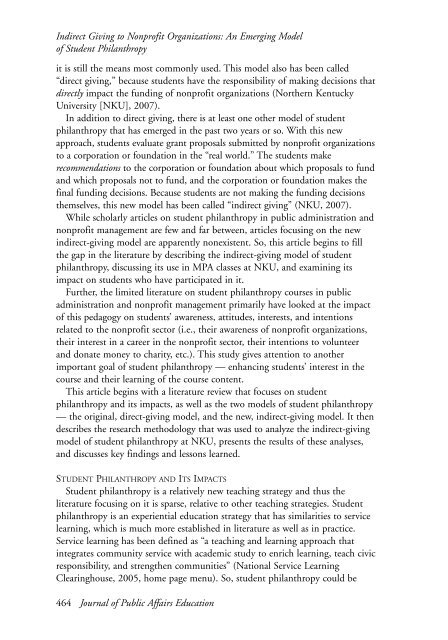JOURNAL OF PUBLIC AFFAIRS EDUCATION - National ...
JOURNAL OF PUBLIC AFFAIRS EDUCATION - National ...
JOURNAL OF PUBLIC AFFAIRS EDUCATION - National ...
You also want an ePaper? Increase the reach of your titles
YUMPU automatically turns print PDFs into web optimized ePapers that Google loves.
Indirect Giving to Nonprofit Organizations: An Emerging Model<br />
of Student Philanthropy<br />
it is still the means most commonly used. This model also has been called<br />
“direct giving,” because students have the responsibility of making decisions that<br />
directly impact the funding of nonprofit organizations (Northern Kentucky<br />
University [NKU], 2007).<br />
In addition to direct giving, there is at least one other model of student<br />
philanthropy that has emerged in the past two years or so. With this new<br />
approach, students evaluate grant proposals submitted by nonprofit organizations<br />
to a corporation or foundation in the “real world.” The students make<br />
recommendations to the corporation or foundation about which proposals to fund<br />
and which proposals not to fund, and the corporation or foundation makes the<br />
final funding decisions. Because students are not making the funding decisions<br />
themselves, this new model has been called “indirect giving” (NKU, 2007).<br />
While scholarly articles on student philanthropy in public administration and<br />
nonprofit management are few and far between, articles focusing on the new<br />
indirect-giving model are apparently nonexistent. So, this article begins to fill<br />
the gap in the literature by describing the indirect-giving model of student<br />
philanthropy, discussing its use in MPA classes at NKU, and examining its<br />
impact on students who have participated in it.<br />
Further, the limited literature on student philanthropy courses in public<br />
administration and nonprofit management primarily have looked at the impact<br />
of this pedagogy on students’ awareness, attitudes, interests, and intentions<br />
related to the nonprofit sector (i.e., their awareness of nonprofit organizations,<br />
their interest in a career in the nonprofit sector, their intentions to volunteer<br />
and donate money to charity, etc.). This study gives attention to another<br />
important goal of student philanthropy — enhancing students’ interest in the<br />
course and their learning of the course content.<br />
This article begins with a literature review that focuses on student<br />
philanthropy and its impacts, as well as the two models of student philanthropy<br />
— the original, direct-giving model, and the new, indirect-giving model. It then<br />
describes the research methodology that was used to analyze the indirect-giving<br />
model of student philanthropy at NKU, presents the results of these analyses,<br />
and discusses key findings and lessons learned.<br />
STUDENT PHILANTHROPY AND ITS IMPACTS<br />
Student philanthropy is a relatively new teaching strategy and thus the<br />
literature focusing on it is sparse, relative to other teaching strategies. Student<br />
philanthropy is an experiential education strategy that has similarities to service<br />
learning, which is much more established in literature as well as in practice.<br />
Service learning has been defined as “a teaching and learning approach that<br />
integrates community service with academic study to enrich learning, teach civic<br />
responsibility, and strengthen communities” (<strong>National</strong> Service Learning<br />
Clearinghouse, 2005, home page menu). So, student philanthropy could be<br />
464 Journal of Public Affairs Education

















